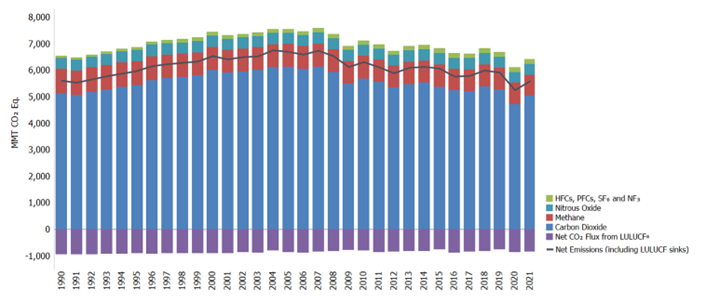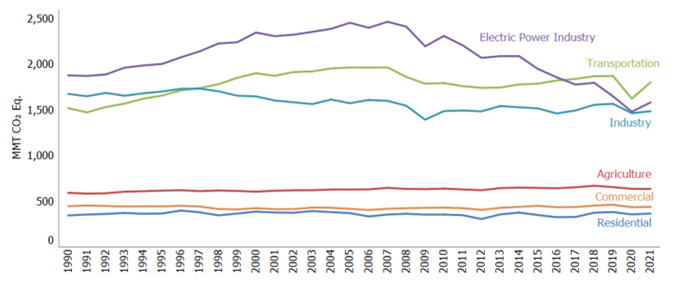30th Annual U.S. Greenhouse Gas Inventory
Posted: May 16th, 2023
Authors: Louise S.
The 30th Annual U.S. Greenhouse Gas (GHG) Inventory is a report that provides information on the sources and sinks of greenhouse gases in the U.S. The newest version was published on April 13, 2023 and compiles the GHG data from 1990 to 2021. The report is produced by the U.S. Environmental Protection Agency (U.S. EPA) and is used to inform policy decisions related to climate change.
What are the Key Findings from the Report?
The report found that in 2021, greenhouse gas emissions in the United States were 6,340 million (6.34 billion) metric tons of carbon dioxide equivalent (CO2e), an increase of 5.2% from 2020. This increase from 2020 was primarily due to the economic rebound in transportation and industrial sectors emissions as a result of the COVID-19 pandemic that occurred in 2020. Net CO2e emissions have decreased by 16.6% from 2005 levels, which is consistent with the overall downward trend. This trend is mostly due to the use of renewable energy in the electric power sector. Figure 1 shows the U.S. GHG emissions trends from 1990 to 2021 (U.S. EPA Document No. 430-F-23-001).
Figure 1
U.S. Greenhouse Gas Emissions and Sinks by Gas

In 2021, carbon dioxide emissions from natural gas increased slightly by 0.5% compared to 2020, while emissions from coal increased significantly by 14.6%, which is the opposite of recent trends. The rise in natural gas emissions was seen across all sectors except for Electric Power and U.S. Territories, while the increase in coal emissions was mainly observed in the Electric Power sector. These increases are due to the economic and traveling rebound after the COVID-19 pandemic in 2020, the overall carbon dioxide emissions are still less than pre-pandemic levels in 2019, as shown in Figure 1. Additionally, emissions from petroleum use increased by 8.6%, and the total CO2 emissions from fossil fuel combustion in 2021 were 1.9% lower than emissions in 1990.
The report also provides information on the sources and sinks of specific greenhouse gases, including carbon dioxide (CO2), methane (CH4), nitrous oxide (N2O), and fluorinated gases. CO2 accounts for the majority of U.S. greenhouse gas emissions, with transportation, electricity generation, and industrial activities being the three largest sources. Transportation accounts for the largest portion of GHG emissions with 28.5% with the lowest sector being residential. The full trends from the GHG emissions by sector are shown in Figure 2 (U.S. EPA Document No. 430-F-23-001).
Figure 2
U.S. Greenhouse Gas Emissions Allocated to Economic Sectors
The Land Use, Land-Use Change and Forestry (LULUCF) sector offset 12% of total emissions in 2021. These activities include reducing deforestation and ecosystem restoration since these activities help in carbon sequestration. An important driver in improving in the LULUCF sector is due to forest management practices.
What is the Direction for the Future?
The U.S. GHG Inventory provides important information for policymakers as they work to address climate change. The report highlights the need to reduce GHG emissions from the transportation and industrial sectors, which are the largest contributors to GHG emissions. It also demonstrates that economic growth and emissions reductions can be achieved simultaneously.
Moving forward, the U.S. will continue to prioritize policies and actions that reduce GHG emissions. This includes transitioning to clean energy sources, promoting energy efficiency, and supporting the development of low-emissions transportation options. Additionally, the U.S. will work with other countries to address global emissions and promote international cooperation on climate change. The President’s Inflation Reduction Act (IRA) of 2022 is also expected to assist in further reductions in GHG emissions.
Conclusions
The 30th Annual U.S. Greenhouse Gas Inventory provides important insights into the sources of GHG emissions in the U.S. While there has been progress in reducing emissions, there is still much work to be done to address climate change. Contact us or your ALL4 Project Manager to discuss how we can help reduce your GHG footprint.


